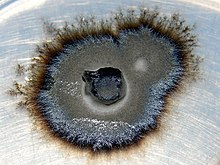Heather family
| Heather family | ||||||||||||
|---|---|---|---|---|---|---|---|---|---|---|---|---|

Corn heather ( Erica spiculifolia ) |
||||||||||||
| Systematics | ||||||||||||
|
||||||||||||
| Scientific name | ||||||||||||
| Ericaceae | ||||||||||||
| Yuss. |

The heather plants (Ericaceae) form a family in the order of the heather-like (Ericales) within the flowering plants (Magnoliopsida). With about 126 genera and about 4000 species they have a worldwide distribution. Species from this family are used as ornamental plants , food, and medicines.
description
In the broad scope of the Ericaceae family based on molecular genetic studies today. l. there are few morphological characteristics common to all subfamilies. The Monotropoideae in particular differ from the more general characteristics of the family.
Vegetative characteristics
They are mostly woody plants: often evergreen or, more rarely, deciduous, small trees , (often heather-like = ericoid) shrubs , rarely lianas or epiphytes . Herbaceous plants are less common. The species of the subfamily Monotropoideae are fleshy, chlorophyllless, mycotrophic plants. Some species form rhizomes , stolons or lignifying tubers from the hypocotyl , which can be up to 1 meter in diameter. Parts of the plant are often hairy with single to multicellular trichomes or scales, which can sometimes be glandular . The shoot axes are more or less pencil-shaped or sometimes clearly winged.
The leaves are alternate and spiral or two-lined, rarely opposite or whorled. Petioles are different or absent. The simple leaf blade is tiny to very large, leathery or herbaceous. The leaf margin is usually smooth or curled, less often toothed or notched. Young leaves are often red in color. Stipules are missing.
Generative characteristics
The flowers are rare individually, usually several in axillary or terminal, racemose , ährigen , capitate, schirmtraubigen or rispigen inflorescences , which are often long droopy. There are durable or perishable bracts and often two bracts per flower. Extra-floral nectaries are rarely present. There is usually a flower stalk.
The mostly odorless flowers are mostly hermaphroditic or, more rarely, functionally unisexual. Only the genus Epigaea is dioecious separately sexed ( diocesan ). The small to large flowers are usually fünfzählig (three to siebenzählig) and radial symmetry or rare something zygomorph mostly double perianth (perianth). In the tribe Rhodoreae the flowers are zygomorphic (for example some species of the genus Rhododendron ). There are usually five (four to seven), free or mostly overgrown sepals . The mostly five (three to seven) petals are mostly fused. Often there is a prominent, nectar-forming discus. There are usually two circles with four to five free, fertile stamens each. For example, Loiseleuria has only one circle with five haplostemonic stamens; in the Styphelioideae there are five, four or only two stamens. The same to unequal stamens are mostly straight or rarely S-shaped, free or fused together and spurs can be formed. The anthers have pores. The pollen grains are usually grouped in tetrahedral tetrads, rarely individually. Most four or five (two to ten) carpels are above a syncarp up from constant ovary grown. There are usually many, rarely just one anatropic to campylotropic ovules per ovary compartment. The stylus usually ends in a cephalic, rarely slightly lobed scar.
Loculicidal or septicidal capsule fruits , berries , stone fruits or, rarely, nut fruits are formed. Sometimes there are still fleshy sepals on the fruit. Usually there are many seeds in each fruit, with Gaylussacia only one per fruit compartment. The small, about 1 to 1.5 mm long seeds have wings or, in Bejaria, appendages. The endosperm is fleshy and the straight embryo is usually white or sometimes green.
The basic chromosome numbers are n = 6, 8, 11, 13, 19 or 23.
ingredients
Many taxa contain polyphenols : tannins , flavonoids and phenolic heterosides (phenol glycosides, iridoids), e.g. arbutin, pyroside, rhododendrin. Often there are poisonous diterpenes, for example acetylandromedol, which makes " rhododendron honey " poisonous.
ecology
Plant species of this family are often found on acidic soil that is poor in minerals, where they receive the necessary nutrients with the help of endomycorrhiza ( symbiosis with soil fungi).
The pollination is done with a few exceptions taxa with upper ovary by insects (often bees , Entomophilie ) and the taxa with inferior ovary by hummingbirds ( ornithophily ).
Systematics and distribution
Plant species of this family occur almost worldwide. All climatic zones and altitudes are populated except for the permafrost zone, so it is only missing on the Antarctic continent. Few species thrive in the tropical lowlands.
The Ericaceae family was founded in 1789 as "Ericae" by Antoine Laurent de Jussieu in Genera Plantarum. Pp. 159-160 first published. Type genus is Erica L. Only synonyms for Ericaceae Juss. are: Vacciniaceae Lindl. Nuttall , Monotropaceae , Pyrolaceae Dum. , Siphonandraceae Klotzsch .
The Ericaceae have long been in the order of the Ericales Bercht. & J.Presl , which has been expanded to include a few families over the past decade. Within the Ericales, the Ericaceae form a clade with the Clethraceae and Cyrillaceae .
The Ericaceae family is divided into eight subfamilies and a total of 24 tribe. There are about 126 genera with about 4000 species in the family .
Here is the complete breakdown of the family into subfamilies and tribe:
- Subfamily Arbutoideae (Meisn.) Nied. : It differs from the other subfamilies mainly in the reduced number of ovules, here there are only a few to one per ovary chamber. The alternate leaves are not needle-like (not "erikoid") reduced. Berries or stone fruits are formed. It contains only one tribe:
- Tribe Arbuteae Meisn. : It contains about six genera ( Arbutus L. , Arctostaphylos Adans. , Arctous (A.Gray) Nied. , Comarostaphylis Zucc. , Ornithostaphylos Small , Xylococcus Nutt. )
- Subfamily Cassiopoideae Kron & Judd :
- Tribe Cassiopeae HTCox ex Stevens : It contains only one genus:
- Scale heather ( Cassiope D. Don )
- Tribe Cassiopeae HTCox ex Stevens : It contains only one genus:
- Subfamily Enkianthoideae Kron, Judd & Anderb. : The alternate or pseudo-whorled leaves are not needle-like (not "erikoid") reduced. It contains only one tribe:
- Tribe Enkiantheae Stevens : It contains only one genus:
- Magnificent bells ( Enkianthus Lour. )
- Tribe Enkiantheae Stevens : It contains only one genus:
- Subfamily Ericoideae Link (including Rhododendroideae (Juss.) Sweet) : With five tribe:
- Tribus Bejarieae Copeland : The petals are free. The anthers have no horns (appendages). It contains about three genera ( Bejaria Mutis , Bryanthus J.G. Gmel. , Ledothamnus Meisn. ).
- Tribus Empetreae D.Don : There are only two or three stamens and only two carpels . The anthers have no horns (appendages). Stone fruits are formed. With three to four genera ( Ceratiola Michx. , Corema D. Don , Diplarche Hook. F. & Thomson , Empetrum L. )
- Tribe Ericeae DC. ex Duby : anthers with or without two horns (appendages). It contains about three genera ( Calluna Salisb. , Daboecia D. Don , Erica L. )
- Tribus Phyllodoceae Drude : There are five to ten stamens. The anthers have no horns (appendages). Capsule fruits are formed. It contains about seven genera ( Elliottia Muhl. Ex Elliott , Epigaea L. , Kalmia L. , Kalmiopsis Rehder , Loiseleuria Desv. , Phyllodoce Salisb. , Rhodothamnus Rchb. )
- Tribus Rhodoreae DC. ex Duby : There are 5 to 15 stamens present. The anthers have no horns (appendages). Capsule fruits are formed. It contains - if you put Diplarche and Menziesia to Rhododendron - only two genera ( Rhododendron L. , Therorhodion (Maxim.) Small ).
- Subfamily Harrimanelloideae Kron & Judd : It contains only one genus:
-
Harrimanella Coville : It includes only two types:
- Moosheide ( Harrimanella hypnoides (L.) Coville ): It is found in Siberia, Finland, Iceland, Svalbard, Jan Mayen , Greenland, eastern Canada and the northeastern United States.
- Harrimanella stelleriana (Pall.) Coville : It occurs in Siberia, Japan and Alaska.
-
Harrimanella Coville : It includes only two types:
- Subfamily Monotropoideae Kostel. (including Pyroloideae): They are mycotrophic plants. It contains three tribes:
- Tribus Monotropeae Dum. : Chlorophyll is absent. It contains about eight genera ( Allotropa Torr. & A. Gray , Cheilotheca Hook. F. , Hemitomes A. Gray , Monotropa L. , Monotropastrum Andres , Monotropsis Schwein. Ex Elliott , Pityopus Small , Pleuricospora A. Gray ).
- Tribus Pterosporeae Baillon : chlorophyll is absent. It contains about two genera ( Pterospora Nutt. , Sarcodes Torr. )
- Tribus Pyroleae Dum. : There is chlorophyll. It contains about four genera ( Chimaphila Pursh , Moneses Salisb. Ex Gray , Orthilia Raf. , Pyrola L. )
- Subfamily Styphelioideae Sweet (Syn .: Epacridoideae Link ): The alternate leaves are not needle-like (not "erikoid") reduced. It contains about seven tribe with about 35 genera and about 420 species:
- Tribus Archerieae Crayn & Quinn : There are only five stamens with short, straight stamens. It contains only one genus ( Archeria Hook. F.)
- Tribus Cosmelieae Crayn & Quinn : There are only five stamens. Capsule fruits are formed. It contains about three genera ( Andersonia R. Br. , Cosmelia R. Br. , Sprengelia Sm. )
- Tribe Epacrideae Dum. : There are only five stamens. Capsule fruits are formed. It contains about five genera ( Budawangia I. Telford , Epacris Cav. , Lysinema R. Br. , Rupicola Maiden & Betche , Woollsia F. Muell. )
- Tribus Oligarrheneae Crayn & Quinn : There are only two or four stamens. The stylus is very short. Stone fruits are formed. It contains about two genera ( Needhamiella L. Watson , Oligarrhena R. Br. )
- Tribus Prionoteae Drude : There are only five stamens with long stamens. It contains about two genera ( Lebetanthus Endl. , Prionotes R. Br. )
- Tribe Richeeae Crayn & Quinn : There are only five stamens. The heady scar is small. Capsule fruits are formed. It contains about three genera ( Dracophyllum Labill. , Richea R. Br. , Sphenotoma (R. Br.) Sweet ).
- Tribe Styphelieae Bartl. : There are only five stamens. Brightly colored drupes are formed. It contains about 19 genera ( Acrotriche R. Br. , Androstoma Hook. F. , Astroloma R. Br. , Brachyloma Sond. , Coleanthera Stschegl. , Conostephium Benth. , Croninia J. M. Powell , Cyathodes Labill. , Cyathopsis Brongn. & Gris , Decatoca F. Muell. , Leptecophylla C. M. Weiller , Leucopogon R. Br. , Lissanthe R. Br. , Melichrus R. Br. , Monotoca R. Br. , Pentachondra R. Br. , Planocarpa C. M. Weiller , Styphelia Sol. Ex Sm. , Trochocarpa R. Br. )
- Subfamily Vaccinioideae Am. : They are epigynous and there are stamen appendages. With five tribes:
- Tribe Andromedeae Klotzsch : Capsule fruits are formed. It contains about two genera ( Andromeda L. , Zenobia D. Don ).
- Tribus Gaultherieae Nied. : Capsule fruits or berries are formed. It contains about ten genera ( Chamaedaphne Moench , Diplycosia Blume , Eubotryoides (Nakai) H. Hara , Eubotrys Nutt. , × Gaulnettya Marchant , Gaultheria L. , Leucothoe D. Don , Pernettya Gaudich. , Pernettyopsis King & Gamble , Tepuia Camp ).
- Tribus Lyonieae Kron & Judd : Capsule fruits are formed. It contains about four genera ( Agarista D. Don ex G. Don , Craibiodendron W. W. Sm. , Lyonia Nutt. , Pieris D. Don ).
- Tribus Oxydendreae Cox : It contains only one genus:
- Oxydendrum DC. : With the only kind of sour tree ( Oxydendrum arboreum (L.) DC. ). It is a deciduous tree that produces capsule fruits.
- Tribe Vaccinieae Rchb. : Berries or stone fruits are formed. Most generic tribe with about 32 genera ( Agapetes D. Don ex G. Don , Anthopteropsis A.C. Sm. , Anthopterus Hook. , Cavendishia Lindl. , Ceratostema Juss. , Costera J.J. Sm. , Demosthenesia A.C. Sm. , Didonica Luteyn & Wilbur , Dimorphanthera ( F. Muell. Ex Drude) F. Muell. , Diogenesia Sleumer , Disterigma (Klotzsch) Nied. , Gaylussacia Kunth , Gonocalyx Planch. & Linden , Macleania Hook. , Mycerinus A.C. Sm. , Notopora Hook. F. , Oreanthes Benth. , Orthaea Klotzsch , Pellegrinia Sleumer , Plutarchia A.C. Sm. , Polyclita A.C. Sm. , Psammisia Klotzsch , Rusbya Britton , Satyria Klotzsch , Semiramisia Klotzsch , Siphonandra Klotzsch , Sphyrospermum Poepp. & Endl. , Symphysia C. Presl , Themistoclesia Klotzsch , Thibaudia Ruiz & Pav . ex J. St.-Hil. , Utleya Wilbur & Luteyn , Vaccinium L. )
.
The following table shows the complete list of genres according to GRIN with details of the subfamily and tribe; also the approximate number of species and their range:
| German and scientific name |
Remarks | Subfamily and tribe |
photos |
|---|---|---|---|
| Acrotriche R.Br. | about 15 species in Australia | Styphelioideae tribe Styphelieae |
|
| Agapetes D.Don ex G.Don | about 80 species from the eastern Himalayas through southwest China and Indochina to Southeast Asia |
Vaccinioideae tribe Vaccinieae |
 Agapetes.serpens Agapetes.serpens
|
| Agarista D.Don ex G.Don | about 31 species most in America |
Vaccinioideae tribe Lyonieae |
 Agarista buxifolia Agarista buxifolia
|
| Allotropa Torr. & A.Gray | with only one species of Allotropa virgata |
Monotropoideae Tribus Monotropeae |
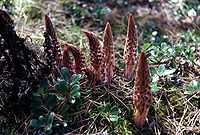 Allotropa virgata Allotropa virgata
|
| Andersonia R.Br. | with about 35 species in western Australia |
Styphelioideae tribe Cosmelieae |
|
| Rosemary heather ( Andromeda L.) | with 1 to 2 species in the northern temperate zone |
Vaccinioideae tribe Andromedeae |
 Rosemary heather ( Andromeda polifolia ) Rosemary heather ( Andromeda polifolia )
|
| Androstoma Hook. f. | with only one species in New Zealand Androstoma empetrifolia Hook. f. |
Styphelioideae tribe Styphelieae |
|
| Anthopteropsis A.C.Sm. | only one species Anthopteropsis insignis A.C.Sm. in central Panama |
Vaccinioideae tribe Vaccinieae |
|
| Anthopterus Hook. | about 12 species in the Neotropic |
Vaccinioideae tribe Vaccinieae | |
| Strawberry trees ( Arbutus L.) | about 10 species in North America, Western Europe, and the Mediterranean |
Arbutoideae tribe Arbuteae |
 Arbutus unedo Arbutus unedo
|
| Archeria Hook. f. | with seven species in Australia and New Zealand |
Styphelioideae tribe Archerieae |
|
| Bearberry ( Arctostaphylos adans.) | 50–65 species | Arbutoideae tribe Arbuteae |
 Arctostaphylos pungens Arctostaphylos pungens
|
| Astroloma R.Br. | about 28 species in Australia | Styphelioideae tribe Styphelieae |
 Astroloma foliosum Astroloma foliosum
|
| Andes roses ( Bejaria Mutis ) | about 15 species in America |
Ericoideae tribe Bejarieae |
 Bejaria imthurnii Bejaria imthurnii
|
| Brachyloma Sond. | with seven species in Australia | Styphelioideae tribe Styphelieae |
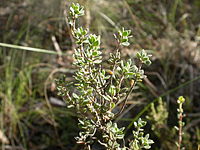 Brachyloma daphnoides Brachyloma daphnoides
|
| Moosheiden ( Bryanthus J.G. Gmel . ) | only one species, Bryanthus gmelinii D.Don in Japan and Kamchatka |
Ericoideae tribe Bejarieae |
 Bryanthus gmelinii Bryanthus gmelinii
|
| Budawangia I. Telford | with only one species in Australia Budawangia gnidioides (Summerh.) I. Telford |
Styphelioideae tribe Epacrideae |
|
| Common heather ( Calluna Salisb. ) | with only one species, Calluna vulgaris (L.) Hull it occurs in Europe and Asia Minor and is naturalized in North America |
Ericoideae tribe Ericeae |
 Common heather ( Calluna vulgaris ) Common heather ( Calluna vulgaris )
|
| Scale heather ( Cassiope D.Don ) | around 17 species circumboreal , as far as China, the Himalayan region, Japan, Russia and western North America |
Cassiopoideae |
 Cassiope mertensiana Cassiope mertensiana
|
| Cavendishia Lindl. | about 150 species in the Neotropic |
Vaccinioideae tribe Vaccinieae |
 Cavendishia allenii Cavendishia allenii
|
| Ceratiola Michx. | with only one species in the USA Ceratiola ericoides Michx. |
Ericoideae tribe Empetreae |
 Ceratiola ericoides Ceratiola ericoides
|
| Ceratostema Juss. | about 33 species in South America |
Vaccinioideae tribe Vaccinieae |
 Ceratostema alatum Ceratostema alatum
|
| Torfgränke ( Chamaedaphne Moench ) | only one species, Chamaedaphne calyculata (L.) Moench found in China, northern Japan , Mongolia , Siberia , northeastern Europe, and North America |
Vaccinioideae Tribus Gaultherieae |
 Peat sear ( Chamaedaphne calyculata ) Peat sear ( Chamaedaphne calyculata )
|
| Cheilotheca Hook. f. | with two kinds they occur between Assam and western Malesia |
Monotropoideae Tribus Monotropeae | |
| Winterlieb ( Chimaphila Pursh ) | 5 kinds in Bhutan , China, Japan, Korea , Russia , Europe, North America and Mexico |
Monotropoideae tribe Pyroleae |
 Winter lovers ( Chimaphila umbellata subsp. Umbellata ) Winter lovers ( Chimaphila umbellata subsp. Umbellata )
|
| Choristemon H.B.Will. | with only one species, Choristemon humilis H.B. Want. it occurs in Australia |
Styphelioideae | |
| Coleanthera Stschegl. | with three kinds they occur in western Australia |
Styphelioideae tribe Styphelieae |
|
| Comarostaphylis Zucc. | with 10 kinds they occur in Mexico |
Arbutoideae |
 Comarostaphylis arbutoides Comarostaphylis arbutoides
|
| Conostephium Benth. | with six species they occur in southern Australia |
Styphelioideae tribe Styphelieae |
|
| Corema D.Don | with two species, one species in Europe and one species in North America |
Ericoideae tribe Empetreae |
 Corema album Corema album
|
| Cosmelia R.Br. | with only one species, Cosmelia rubra R.Br. it occurs in southwestern Australia |
Styphelioideae tribe Cosmelieae |
|
| Costera J.J.Sm. | with about nine species they occur in western Malesia |
Vaccinioideae tribe Vaccinieae |
|
| Craibiodendron W.W.Sm. | 5 species in Cambodia , China, India , Laos , Myanmar , Thailand and Vietnam |
Vaccinioideae tribe Lyonieae |
|
| Croninia J.M. Powell | with only one species, Croninia kingiana (F. Muell.) J. Powell it occurs in Western Australia |
Styphelioideae tribe Styphelieae |
|
| Cyathodes Labill. | with three kinds they occur in Tasmania |
Styphelioideae tribe Styphelieae |
|
| Cyathopsis Brongn. & Gris | with only one species, Cyathopsis floribunda Brongn. & Gris it occurs in New Caledonia |
Styphelioideae tribe Styphelieae |
|
| Gloss heather ( Daboecia D.Don ) | with only two species they occur from Ireland to Spain and the Azores |
Ericoideae tribe Ericeae |
 Daboecia cantabrica Daboecia cantabrica
|
| Decatoca F. Muell. | with only one species, Decatoca spenceri F. Muell. it occurs in New Guinea |
Styphelioideae tribe Styphelieae |
|
| Demosthenesia A.C.Sm. | about 11 species in South America |
Vaccinioideae tribe Vaccinieae |
|
| Didonica Luteyn & Wilbur | with 4 kinds in Central America |
Vaccinioideae tribe Vaccinieae |
|
| Dimorphanthera (F.Muell. Ex Drude) F.Muell. | with about 75 kinds they occur in Malesia, especially on New Guinea |
Vaccinioideae tribe Vaccinieae |
|
| Diogenesia Sleumer | about 13 species in South America |
Vaccinioideae tribe Vaccinieae |
|
| Diplycosia flower | with about 111 species | Vaccinioideae Tribus Gaultherieae |
|
| Disterigma (Klotzsch) Nied. | 35–40 species in the Neotropic |
Vaccinioideae tribe Vaccinieae |
|
| Dragon leaves ( Dracophyllum Labill. ) | with about 48 kinds they occur in Australia, New Caledonia and especially in New Zealand |
Styphelioideae tribe Richeeae |
 Dracophyllum secundum Dracophyllum secundum
|
| Elliottia Muhl. ex Elliott | with four kinds they occur in Japan, North America and Alaska |
Ericoideae tribe Phyllodoceae |
 Elliottia pyroliflora Elliottia pyroliflora
|
| Crowberries ( Empetrum L. ) | 3–18 species with disjoint area in North America, southern South America, northern Eurasia and on southern Atlantic islands; circumboreal, subarctic, alpine, bipolar |
Ericoideae tribe Empetreae |
 Black crowberry ( Empetrum nigrum ) Black crowberry ( Empetrum nigrum )
|
| Magnificent bells ( Enkianthus Lour. ) | about 12 species from the eastern Himalayas to China to Japan and Indochina |
Enkianthoideae |
 Enkianthus perulatus Enkianthus perulatus
|
| Australheide ( Epacris Cav. ) | with about 40 species they occur in Australia, New Zealand and New Caledonia |
Styphelioideae tribe Epacrideae |
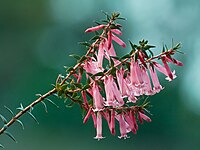 Pink shape of Epacris impressa Pink shape of Epacris impressa
|
| Soil Laurel ( Epigaea L. ) | with three species of a species in Japan, one in the Middle East and one in eastern North America |
Ericoideae tribe Phyllodoceae |
 Epigaea asiatica Epigaea asiatica
|
| Heather ( Erica L .; Syn .: Bruckenthalia Rchb. , Philippia Klotzsch ) | with about 860 species they occur mainly in southern Africa, but also in the mountains of tropical Africa, in Madagascar, in the Mediterranean region, in Macaronesia and in Europe |
Ericoideae tribe Ericeae |
 Erica scabriuscula on site Erica scabriuscula on site
|
| × Gaulnettya Marchant | Hybrid genus Gaultheria × Pernettya | Vaccinioideae Tribus Gaultherieae |
|
| Mock berries ( Gaultheria L. ) | about 115 species in eastern and southern Asia, southeastern Australia , Tasmania , Pacific Islands (New Zealand), North and South America |
Vaccinioideae Tribus Gaultherieae |
 Gaultheria miqueliana Gaultheria miqueliana
|
| Humpbackberries ( Gaylussacia Kunth ) | about 50 species in the Neotropic |
Vaccinioideae tribe Vaccinieae |
 Gaylussacia brachycera Gaylussacia brachycera
|
| Gonocalyx planch . & Linden | about nine species in Central America and on Caribbean islands |
Vaccinioideae tribe Vaccinieae |
|
| Harrimanella Coville | with only two species they occur in the Arctic and Subarctic |
Harrimanelloideae |
 Harrimanella hypnoides Harrimanella hypnoides
|
| Hemitomes A. Gray | with only one species, Hemitomes congestum A. Gray, it occurs in the western USA |
Monotropoideae Tribus Monotropeae |
 Hemitomes congestum Hemitomes congestum
|
| Laurel roses ( Kalmia L. ) | 7 species in the New World |
Ericoideae tribe Phyllodoceae |
 Kalmia latifolia 'Olympic Wedding' Kalmia latifolia 'Olympic Wedding'
|
| Kalmiopsis Rehder | with only one species, Kalmiopsis leachiana (L. Henderson) Rehder, it occurs only in Oregon |
Ericoideae tribe Phyllodoceae |
 Kalmiopsis leachiana Kalmiopsis leachiana
|
| Lebetanthus Endl. | with only one species, Lebetanthus myrsinites (Lam.) Dusén it occurs in southern South America |
Styphelioideae tribe Prionoteae |
|
| Ledothamnus Meisn. | 7 species only in the Guiana highlands |
Ericoideae tribe Bejarieae |
 Ledfothamnus sessilifolius Ledfothamnus sessilifolius
|
| Leptecophylla C.M.Weiller | with about 13 species they come from New Guinea, Australia and New Zealand to Hawaii |
Styphelioideae tribe Styphelieae |
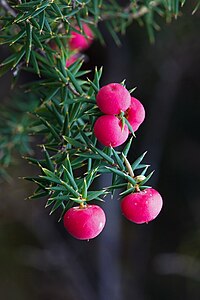 Leptecophylla juniperina Leptecophylla juniperina
|
| Leucopogon R.Br. | with about 23 species they come from Malesia and Australia to New Caledonia |
Styphelioideae tribe Styphelieae |
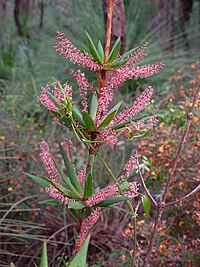 Leucopogon verticillatus Leucopogon verticillatus
|
| Grape heather ( Leucothoe D.Don ) | about 6 species in eastern Asia and the southeastern USA |
Vaccinioideae Tribus Gaultherieae |
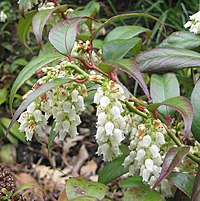 Leucothoe fontanesiana Leucothoe fontanesiana
|
| Lissanthe R.Br. | with nine kinds they occur in Australia |
Styphelioideae tribe Styphelieae |
 Lissanthe strigosa subsp. subulata Lissanthe strigosa subsp. subulata
|
| Gämsheide ( Loiseleuria Desv. ) | with only one species, Loiseleuria procumbens (L.) Desv. it occurs in Europe, Asia and North America |
Ericoideae tribe Phyllodoceae |
 Gämsheide ( Loiseleuria procumbens ) Gämsheide ( Loiseleuria procumbens )
|
| Lyons ( Lyonia Nutt. ) | about 36 species in eastern Asia and North America |
Vaccinioideae tribe Lyonieae |
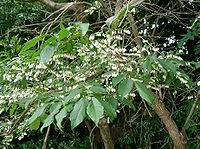 Lyonia ovalifolia Lyonia ovalifolia
|
| Lysinema R.Br. | with about five species they occur in southwestern Australia |
Styphelioideae tribe Epacrideae |
|
| Macleania Hook. | about 38 species in South America |
Vaccinioideae tribe Vaccinieae |
 Macleania rupestris Macleania rupestris
|
| Malea Lundell | with only one species, Malea pilosa Lundell it occurs in Mexico |
||
| Melichrus R.Br. | with four kinds they occur in Australia |
Styphelioideae tribe Styphelieae |
 Melichrus urceolatus Melichrus urceolatus
|
| Mitrastylus Alm & TCEFr. | with a maximum of two species they occur in Madagascar |
Ericoideae tribe Ericeae |
|
| Moneses Salisb. ex Gray | one or two species in Eurasia and North America |
Monotropoideae tribe Pyroleae |
 Moss eye ( Moneses uniflora ) Moss eye ( Moneses uniflora )
|
| Monotoca R.Br. | with about 17 kinds they occur in Australia |
Styphelioideae tribe Styphelieae |
|
| Spruce asparagus ( Monotropa L. ) | only two species in cool to temperate areas mainly in the northern hemisphere, but also in South America |
Monotropoideae Tribus Monotropeae |
 Monotropa hypopitys Monotropa hypopitys
|
| Monotropastrum Andres | only two species in Bhutan, China, India, Indonesia ( Sumatra ), Japan (including the Ryūkyū Islands), Korea, Laos, Myanmar, Nepal , Sakhalin , Sikkim, Thailand and Vietnam |
Monotropoideae Tribus Monotropeae |
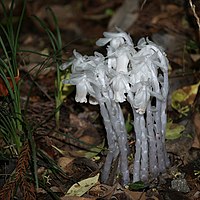 Monotropastrum humile Monotropastrum humile
|
| Monotropsis pig. ex Elliott | with only one species, Monotropsis odorata pig. it occurs in the southeastern United States |
Monotropoideae Tribus Monotropeae |
 Monotropsis odorata Monotropsis odorata
|
| Mycerinus A.C.Sm. | 3 species only in the Guiana Hichland |
Vaccinioideae tribe Vaccinieae |
|
| Needhamiella L. Watson | with only one species, Needhamiella pumilio (R. Br.) L. Watson, it occurs in southwestern Australia |
Styphelioideae tribe Oligarrheneae |
|
| Notopora Hook. f. | 5 species only in the Guiana Hichland |
Vaccinioideae tribe Vaccinieae |
|
| Oligarrhena R.Br. | with only one species, Oligarrhena micrantha R. Br. it occurs in Australia |
Styphelioideae tribe Oligarrheneae |
|
| Oreanthes Benth. | 7 species in mountainous regions of South America |
Vaccinioideae tribe Vaccinieae |
|
| Ornithostaphylos Small | with only one species, Ornithostaphylos oppositifolia (C. Parry) Small it occurs in Southern California and Baja California |
Arbutoideae | |
| Orthaea Klotzsch | about 32 species in the Neotropic |
Vaccinioideae tribe Vaccinieae | |
| Pear green ( Orthilia Raf. ) | only one or two species circumboreal |
Monotropoideae tribe Pyroleae |
 Orthilia secunda Orthilia secunda
|
| Sauerbaum ( Oxydendrum DC. ) | only one species, Oxydendrum arboreum (L.) DC. it occurs in the USA |
Vaccinioideae tribe Oxydendreae |
 Sauerbaum ( Oxydendron arboreum ) Sauerbaum ( Oxydendron arboreum )
|
| Pellegrinia Sleumer | 5 species only in central Peru |
Vaccinioideae tribe Vaccinieae |
|
| Pentachondra R.Br. | with about four kinds they occur in South Australia to New Zealand |
Styphelioideae tribe Styphelieae |
|
| Pernettya Gaudich. | about 14 species | Vaccinioideae Tribus Gaultherieae |
 Pernettya mucronata Pernettya mucronata
|
| Pernettyopsis King & Gamble | with a maximum of four species | Vaccinioideae Tribus Gaultherieae |
|
| Moosheiden ( Phyllodoce Salisb. ) | about 7 species widespread in temperate areas of the northern hemisphere |
Ericoideae tribe Phyllodoceae |
 Phyllodoce empetriformis Phyllodoce empetriformis
|
| Lavender heather ( Pieris D.Don ) | about 7 species with disjoint area (East Asia and North America) |
Vaccinioideae tribe Lyonieae |
 Pieris japonica 'Mountain Fire' Pieris japonica 'Mountain Fire'
|
| Pityopus Small | with only one species, Pityopus californica (Eastw.) H. Copel. it occurs in western North America |
Monotropoideae Tribus Monotropeae | |
| Planocarpa C.M.Weiller | with three kinds they occur in Tasmania |
Styphelioideae tribe Styphelieae |
|
| Pleuricospora A. Gray | with only one species, Pleuricospora fimbriolata A. Gray, it occurs in western North America |
Monotropoideae Tribus Monotropeae |
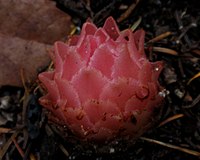 Pleuricospora fimbriolata Pleuricospora fimbriolata
|
| Plutarchia A.C.Sm. | about 10 species at higher altitudes in South America |
Vaccinioideae tribe Vaccinieae |
|
| Polyclita A.C.Sm. | only one kind of Polyclita turbinata (O.Ktze.) ACSm. in northern Bolivia |
Vaccinioideae tribe Vaccinieae |
|
| Prionotes R.Br. | with only one species, Prionotes cerinthoides R.Br. it occurs in Tasmania |
Styphelioideae tribe Prionoteae |
|
| Psammisia Klotzsch | about 70 species in South America |
Vaccinioideae tribe Vaccinieae |
|
| Pterospora Nutt. | only one species, Pterospora andromedea Nutt. it occurs in western North America |
Monotropoideae tribe Pterosporeae |
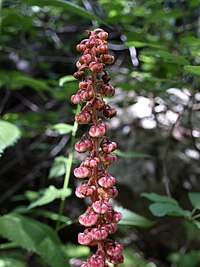 Pterospora andromedea Pterospora andromedea
|
| Wintergreen ( Pyrola L. ) | 20–40 species mainly in the northern hemisphere |
Monotropoideae tribe Pyroleae |
 Pyrola grandiflora Pyrola grandiflora
|
| Rhododendrons ( Rhododendron L. ) | Since 2011 including Diplarche Hook. f. & Thomson , Menziesia Sm. About 850–1000 species in Eurasia and North America |
Ericoideae tribe Rhodoreae |
 Rhododendron concinnum Rhododendron concinnum
|
| Pygmy gall rose ( Rhodothamnus rchb. ) | with only two species they occur in the eastern Alps and in northeastern Turkey, including Rhodothamnus chamaecistus |
Ericoideae tribe Phyllodoceae |
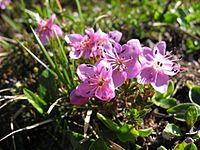 Rhodothamnus chamaecistus Rhodothamnus chamaecistus
|
| Richea R.Br. | with eleven species they occur in southeastern Australia |
Styphelioideae tribe Richeeae |
 Richea scoparia Richea scoparia
|
| Rupicola Maiden & Betche | with up to five types | Styphelioideae tribe Epacrideae |
|
| Rusbya Britton | only one species, Rusbya taxifolia Britton in northern Bolivia |
Vaccinioideae tribe Vaccinieae |
|
| Sarcodes Torr. | with only one species, Sarcodes sanguinea Torr. it occurs in the western United States and Mexico |
Monotropoideae tribe Pterosporeae |
 Sarcodes sanguinea Sarcodes sanguinea
|
| Satyria Klotzsch | about 23 species in the Neotropic |
Vaccinioideae tribe Vaccinieae |
 Satyria warszewiczii Satyria warszewiczii
|
| Semiramisia Klotzsch | 4 species in mountainous regions of South America |
Vaccinioideae tribe Vaccinieae |
|
| Siphonandra Klotzsch | 3 types in South America |
Vaccinioideae tribe Vaccinieae |
|
| Sphenotoma (R.Br.) Sweet | with six species they occur in southwestern Australia |
Styphelioideae tribe Richeeae |
|
| Sphyrospermum Poepp. & Endl. | about 21 species in the Neotropic |
Vaccinioideae tribe Vaccinieae |
 Sphyrospermum cordifolium Sphyrospermum cordifolium
|
| Sprengelia Sm. | with five kinds, four kinds in Australia and one kind in New Zealand |
Styphelioideae tribe Cosmelieae |
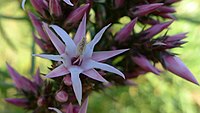 Sprengelia incarnata Sprengelia incarnata
|
| Styphelia Sol. ex Sm. | with 15 species they occur in southern Australia |
Styphelioideae tribe Styphelieae |
 Styphelia tameiameiae Styphelia tameiameiae
|
| Symphysia C. Presl | with 15 kinds they occur in Central America |
Vaccinioideae tribe Vaccinieae |
|
| Tepuia Camp | 7 species only in the Guiana highlands |
Vaccinioideae Tribus Gaultherieae |
|
| Themistoclesia Klotzsch | about 25 species in South America |
Vaccinioideae tribe Vaccinieae |
|
| Therorhodion (Maxim.) Small | with two kinds they occur in Northeast Asia and in western Alaska |
Ericoideae tribe Rhodoreae |
 Therorhodion camtschaticum Therorhodion camtschaticum
|
| Thibaudia Ruiz & Pav. Ex J.St.-Hil. (Syn .: Calopteryx A.C.Sm. ) | about 60 species in South America |
Vaccinioideae tribe Vaccinieae |
|
| Wheel fruits ( Trochocarpa R.Br. ) | with about 12 kinds they occur in Malesia and in eastern Australia |
Styphelioideae tribe Styphelieae |
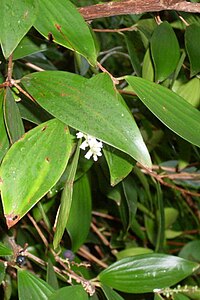 Trochocarpa laurina Trochocarpa laurina
|
| Utleya Wilbur & Luteyn | only one species Utleya costaricensis Wilbur & Luteyn in central Costa Rica |
Vaccinioideae tribe Vaccinieae |
|
| Blueberries ( Vaccinium L. ) | about 100–300 species with a wide distribution with a focus on the northern hemisphere |
Vaccinioideae tribe Vaccinieae |
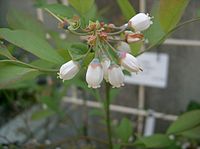 Flowers of Vaccinium ashei 'Homebell' Flowers of Vaccinium ashei 'Homebell'
|
| Woollsia F. Muell. | with only one species, Woollsia pungens (Cav.) F.Muell. it occurs in northeastern Australia |
Styphelioideae tribe Epacrideae |
 Woollsia pungens Woollsia pungens
|
| Xylococcus Nutt. | with only one species, Xylococcus bicolor Nutt. | Arbutoideae tribe Arbuteae |
 Xylococcus bicolor Xylococcus bicolor
|
| Zenobia ( Zenobia D.Don ) | only one species, Zenobia pulverulenta (Willd.) Pollard , occurs in the southeastern USA |
Vaccinioideae tribe Andromedeae |
 Zenobia pulverulenta Zenobia pulverulenta
|
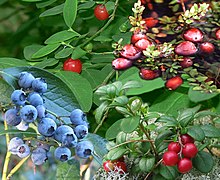
use
Many species and their varieties are used as ornamental plants in parks, gardens and buildings.
The fruits of some species are eaten.
The medicinal effects of many species have been studied. For example, drugs from Arctostaphylos uva-ursi (Uvae-ursi folium - bearberry leaves), Vaccinium myrtillus (Myrtilli fructus - blueberry fruits) and Vaccinium vitis-idaea (Vitis ideae folium - cranberry leaves) are used.
swell
- Description, systematics and distribution maps of the Ericaceae family and all subfamilies on the AP website. (Sections systematics and description)
- Mingyuan Fang, Ruizheng Fang, Mingyou He, Linzheng Hu, Hanbi Yang, Haining Qin, Tianlu Min, David F. Chamberlain, Peter F. Stevens, Gary D. Wallace, Arne A. Anderberg: Ericaceae. , from p. 242 - online with the same text as the printed work , In: Wu Zheng-yi, Peter H. Raven, Deyuan Hong (Ed.): Flora of China. Volume 14: Apiaceae through Ericaceae. Science Press and Missouri Botanical Garden Press, Beijing and St. Louis. 2005, ISBN 1-930723-41-5 . (Sections Description, Distribution and Systematics)
- Gordon C. Tucker: Ericaceae. , from p. 370 - same text online as the printed work , In: Flora of North America Editorial Committee (Ed.): Flora of North America North of Mexico. Volume 8: Magnoliophyta: Paeoniaceae to Ericaceae. Oxford University Press, New York and Oxford, 2009, ISBN 978-0-19-534026-6 . (Sections Description, Distribution and Systematics)
- The Ericaceae family without the Monotropoideae at DELTA by L. Watson & MJ Dallwitz. (engl.)
- James L. Luteyn, Paola Pedraza-Peñalosa: Neotropical Blueberries - The Plant Family Ericaceae : Website of the New York Botanical Garden .
- Kathleen A. Kron, James L. Luteyn: Origins and biogeographic patterns in Ericaceae: New insights from recent phylogenetic analyzes. In: Biologiske Skrifter. Volume 55, 2005, pp. 479-500.
- James L. Luteyn, Robert L. Wilbur: Flora Costaricensis: Family # 172 Ericaceae. In: Fieldiana Botany. Volume 45, 2005, pp. 1–104: doi : 10.3158 / 0015-0746 (2005) 45 [1: FCFE] 2.0.CO; 2
- Kathleen A. Kron, WS Judd, Peter F. Stevens, DM Crayn, Arne A. Anderberg, PA Gadek, CJ Quinn, James L. Luteyn: A phylogenetic classification of Ericaceae: Molecular and morphological evidence. In: Botanical Review. Volume 68, 2002, pp. 335-423. doi : 10.1663 / 0006-8101 (2002) 068 [0335: PCOEMA] 2.0.CO; 2
- Ericaceae homepage from Kathleen A. Kron. (English speaking)
Individual evidence
- ↑ JWG Cairney, AA Meharg: ericoid mycorrhiza: a partnership did exploits harsh edaphic conditions. In: European Journal of Soil Science. Volume 54, 2003, pp. 735-740.
- ↑ LC Hileman u. a .: Phylogeny and biogeography of the Arbutoideae (Ericaceae): implications for the Madrean-Tethyan hypothesis. In: Syst. Bot. 26, 2001, pp. 131-143.
- ↑ a b L. A. Craven: Diplarche and Menziesia transferred to Rhododendron (Ericaceae). In: Blumea. Volume 56, 2011, p. 34 doi: 10.3767 / 000651911X568594
- ↑ a b c Ericaceae in the Germplasm Resources Information Network (GRIN), USDA , ARS , National Genetic Resources Program. National Germplasm Resources Laboratory, Beltsville, Maryland. Retrieved October 15, 2017.
- ↑ CM Bush, L. Lu, PW Fritsch, D.-Z. Li, KA Kron: Phylogeny of Gaultherieae (Ericaceae: Vaccinioideae) based on DNA sequence data from matK, ndhF, and nrITS. In: Internat. J. Plant Sci. 170, 2009, pp. 355-364.
- ↑ Kathleen A. Kron, E. Ann Powell, James L. Luteyn: Phylogenetic relationships within the blueberry tribe (Vaccinieae, Ericaceae) based on sequence data from MATK and nuclear ribosomal ITS regions, with comments on the placement of Satyria. In: American Journal of Botany. 89, 2002, pp. 327-336.
- ^ David John Mabberley: Mabberley's Plant-Book. A portable dictionary of plants, their classification and uses. 3. Edition. Cambridge University Press, 2008, ISBN 978-0-521-82071-4 .
- ↑ a b Entries on Ericaceae in Plants For A Future . Retrieved October 15, 2017.

